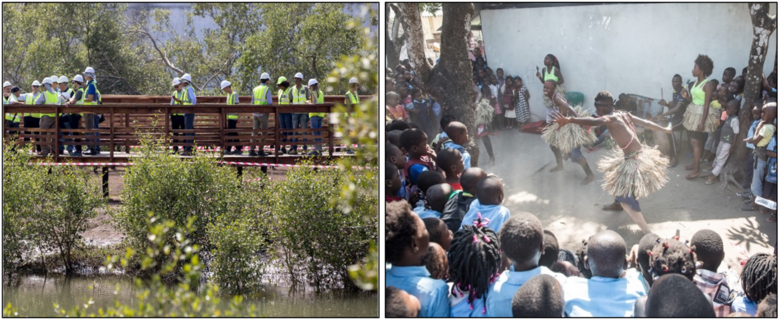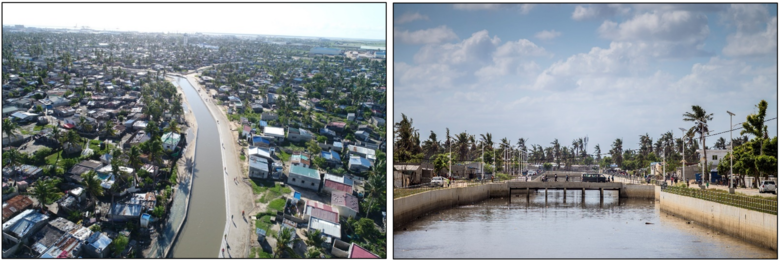Building Resilience Through Green-Gray Infrastructure: Lessons from Beira
Feature Story by The World Bank | Originally p
STORY HIGHLIGHTS
- For cities threatened by climate change, bringing together green and grey infrastructure may be the key to climate-proofing them and saving lives.
- Recent investments in the coastal city of Beira in Mozambique showcase how cities can implement new infrastructure that brings not just climate benefits, but socio-economic and environmental benefits, too.
Mozambique is among the planet's most vulnerable countries when it comes to climate risks—and also one of the poorest. In 2019, Cyclone Idai, one of the strongest and deadliest cyclones on record to hit Africa, demonstrated the need for resilience-building investments in Mozambique’s coastal cities.
Beira in particular, named one of the world’s cities most threatened by climate change, is showing how other cities in the country and across Africa can combine innovative green approaches and conventional gray infrastructure to protect residents and assets from climate hazards, while enhancing ecosystems and services.
The World Bank and its development partners have been providing much-needed financing to support these efforts on the ground, in particular, through the Cities and Climate Change Project (3CP). This project, which was implemented by Mozambique’s Administration for Water and Sanitation Infrastructure (AIAS) in coordination with the Municipality of Beira, financed conventional gray interventions, such as upgrades and extensions of inadequate drainage systems, as well as green nature-based solutions (NBS), which focused on restoring the Chiveve River’s capacity to mitigate floods in Beira.
Why Focus on the Chiveve River?
The Chiveve River is a 3.5 km tidal river that traverses Beira’s central business district and spans from the city’s fishing port to lower income neighborhoods in the southeast. The river was a focus of the project’s intervention, as its intrinsic ability to absorb and mitigate floods, while also providing other societal benefits, had been significantly reduced. The river itself, its mangroves and native vegetation had been severely degraded, cut off from its natural tidal flow, choked by trash, and polluted by fecal waste.
The “Green Urban Infrastructure,” the NBS component supported under 3CP with financing from the Pilot Program for Climate Resilience and Germany, has transformed the formerly degraded river and surrounding area into a green urban park. It will provide recreational spaces, enhance local revenue, and improve resilience by absorbing and reducing floodwaters brought by increasing climate events.
The Approach: Bringing Green and Gray Together
Understanding the challenges at hand, government officials and municipal leaders proposed a project to comprehensively address the issues by investing in green and non-structural measures in conjunction with traditional gray interventions. The goal was to enhance climate resilience while improving the quality of life for city dwellers through the provisioning of recreational, environmental, and economic opportunities as an added value of NBS.
In an initial phase, community-based mangrove restoration was completed. The city also brought together community groups to lead river clean-ups, establish a waste-collection program for informal settlements, and create outreach campaigns to raise awareness about the river’s importance and role in mitigating urban flooding. This was done alongside gray interventions that included widening the river’s tidal basin to increase its stormwater retention function and building a controllable tidal outlet to regulate the incoming and outgoing flow.
The “Green Urban Infrastructure” phase under 3CP focused on expanding the aforementioned work to create a 17-hectare, multi-functional urban green park along the river. This included the continued restoration and preservation of Chiveve’s stormwater drainage and retention function by rehabilitating its degraded mangroves and native flora. The project also increased the number of recreational and public spaces alongside the river by constructing pedestrian routes, event venues, a local market, kiosks, and other community areas.

Expansion of the urban green park (left), and cultural outreach campaigns (right)
The project aims to ultimately increase the perceived and realized value of the river’s space, reducing future encroachment and leveraging the new economic infrastructure as a funding source for the continued operation and maintenance of the park. The Chiveve is now flowing healthier than before, sans trash and waste, and residents feel safer in areas around the park. The green park is estimated to provide enhanced flood protection for about 50,000 people, which is in addition to the flood protection benefits provided to an estimated 234,000 people by the drainage system rehabilitated under 3CP.

WBG President David Malpass visits Beira and the rehabilitated stormwater drainage system after Cyclone Idai in 2019 (left). The ceremonial unveiling of Beira’s urban green park by the President of Mozambique, Felipe Nyusi, in December 2024 (right).
Moving Forward
Building on these results, the new Cyclone Idai and Kenneth Emergency Recovery and Resilience Project (CERRP) is taking the support for a climate-resilient Beira a step further. World Bank financing under CERRP also mobilized co-financing from the Netherlands (RVO, or The Netherlands Enterprise Agency) and Germany (KfW) for drainage and coastal resilience investments. In addition, support provided by the World Bank’s Global Program on Nature-Based Solutions and the Program on Forests (PROFOR) helped capture lessons learned and best practices from the integrated intervention in Beira under 3CP, which are informing technical preparatory studies for the investments under CERRP, and exploring how similar interventions could be adopted in other Mozambican coastal cities.
Retrieved from https://www.worldbank.org/en/news/feature/2022/01/31/building-resilience-through-green-gray-infrastructure-lessons-from-beira



